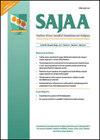Smartphone and app usage amongst South African anaesthetic service providers
IF 0.3
Q4 ANESTHESIOLOGY
Southern African Journal of Anaesthesia and Analgesia
Pub Date : 2021-04-01
DOI:10.36303/sajaa.2021.27.2.2461
引用次数: 1
Abstract
Background: Mobile medical applications have evolved rapidly in the 21st century, making it easier for anaesthetic service providers to utilise these for work-related queries. However, there is no South African data available to determine if this technology is being utilised. The usage patterns of mobile medical health applications and the accessibility of this technology to a resource-limited environment, along with a focus on what apps South African anaesthetic service providers are using was assessed and quantified. Secondly, the favourability of a South African-based app and any possible barriers to entry were examined. Methods: A prospective, contextual, descriptive study was conducted amongst anaesthetic service providers attending the 2018 South African Society of Anaesthesiologists National Congress in Cape Town. Two hundred and thirty-two (116 specialists and 116 registrars) surveys were completed voluntarily between 4 to 8 April 2018, and analysed. Results: 100% of participants utilise smartphones for work-related queries. 169/232 (72%) participants favoured a South African-based app. Drug referencing and calculator functionality were the most frequently used mobile applications. Specialists were more likely to admit to nonprofessional use of smartphones in theatre. High data costs contribute to decreased usage amongst respondents. Conclusions: A South African-based pharmacology app would be welcomed and utilised by the South African anaesthetic community. Smartphone and app usage patterns, as well as limitations to this technology usage in South Africa appear to reflect those seen worldwide. Poor internet connectivity and high data costs were limiting factors to technology utilisation.南非麻醉服务提供商的智能手机和应用程序使用情况
背景:移动医疗应用在21世纪发展迅速,使麻醉服务提供商更容易利用这些应用进行与工作相关的查询。然而,南非没有可用的数据来确定是否正在使用这项技术。对移动医疗健康应用程序的使用模式和这项技术在资源有限的环境中的可访问性,以及对南非麻醉服务提供商正在使用的应用程序的关注进行了评估和量化。其次,研究了南非应用程序的受欢迎程度以及任何可能的进入障碍。方法:在开普敦参加2018年南非麻醉师协会全国代表大会的麻醉服务提供者中进行了一项前瞻性、情境性、描述性研究。在2018年4月4日至8日期间,自愿完成了232项调查(116名专家和116名登记员),并进行了分析。结果:100%的参与者使用智能手机进行与工作相关的查询。169/232名(72%)参与者喜欢南非的应用程序。药物参考和计算器功能是最常用的移动应用程序。专家们更可能承认在剧院里非专业使用智能手机。高数据成本导致受访者使用率下降。结论:基于南非的药理学应用程序将受到南非麻醉界的欢迎和使用。智能手机和应用程序的使用模式,以及南非对这项技术使用的限制,似乎反映了世界各地的情况。糟糕的互联网连接和高昂的数据成本是限制技术利用的因素。
本文章由计算机程序翻译,如有差异,请以英文原文为准。
求助全文
约1分钟内获得全文
求助全文
来源期刊

Southern African Journal of Anaesthesia and Analgesia
ANESTHESIOLOGY-
CiteScore
0.90
自引率
0.00%
发文量
10
 求助内容:
求助内容: 应助结果提醒方式:
应助结果提醒方式:


